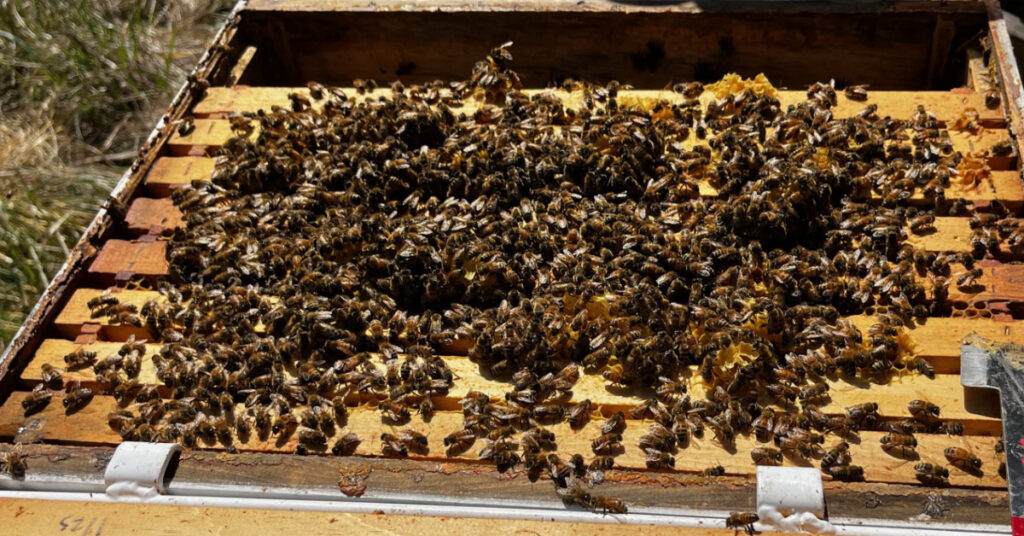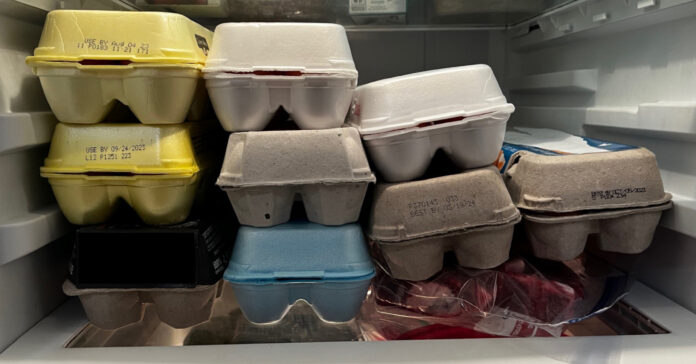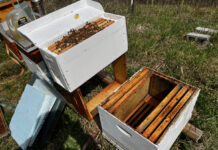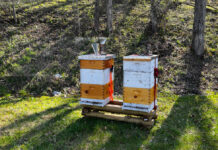My wife sold 10 dozen eggs at an event earlier in the week, our biggest sales day yet. Since that is a week’s worth of eggs, we had to save up for the event, filling our refrigerator with egg cartons. Because we have some regular customers who buy weekly, we had to make sure we had enough eggs to take care of them first. Right now, free-range eggs are between 4 and $4.50 at Walmart, so our price of $5 a dosen is competitive enough that folks will buy them.
Selling eggs can be a balancing act. Some weeks we can’t seem to get rid of the extra eggs, and then a week like this comes along and we sell out. But since we average 18 new eggs per day, if things get tight, we can push someone off a day and deliver a dozen very fresh eggs the following day. If we had a bigger refrigerator, we could save more!
As much as I enjoy earning up to an extra $50 a week, all-we-can eat eggs remains an important benefit and is the primary reason we raise chickens. We usually consume two dozen a week, more if my wife bakes. They are also an important source of fresh food in our prepping calculations and a candidate for bartering in a post-SHTF scenario.
Too Many Bees?
I took a deep dive into my bee hives last week and four of the five are surprisingly strong. Granted, this is only my third spring with bees at this location, but it is the first time I have seen the hives this strong this early. I am going to have to check weekly to make sure there are not any queen cells forming. I’m also going to have to start splitting my hives sooner than ever before. If all goes well, however, that will translate into more hives and more honey by the end of the year.
One hive had so much brood in the upper box I decided to move the box to the bottom and put the bottom box on top, a process called reversal. But when I started inspecting frames in the bottom box, there were already three frames of brood down there. Flip flopping the top and bottom would not have accomplished much, but I did checkerboard some frames to give the queen room to lay.

Besides lots of bees and brood, the hives held entire frames of pollen from multiple sources. I also had frames of honey, mostly what we call wet-capped honey. I don’t know if this is new honey or honey they never consumed over the winter. In any case, the hives don’t appear to be in any danger of starving.
Of course, the last hive I opened had the least number of bees in it. This hive looks more like I would expect them to look in mid-March. Next time, I will open it first and then give it a couple of frames of bees from other hives.
In addition to having lots of eggs, we may have a bumper crop of honey. Too soon to tell—a cold snap could harm the hives or stop the early honey flow by killing buds and preventing trees from flowering. We are crossing our fingers.
Hiking up the Mountain
The dog and I took advantage of the nice weather this past week to hike up the mountain. I inspected our spring, the cistern, and checked the overflow. Everything looked to be in good shape, meaning we made it through the winter with our water supply infrastructure intact.
I also established a new ammo cache, although it is not yet fully stocked. The .50 caliber ammo can contains two AR magazines loaded with .300 blackout, 60 additional rounds in stripper clips, and some emergency food, including a box of NRG-5 emergency food rations. Recently, I purchased flavored oatmeal packets and some powdered soups just for our caches. I like these because it does not harm them if the cache freezes. I can also reconstitute them with cold water. It may not be as tasty cold, but it will be edible. Everything in the cache is protected in zip-lock bags, just in case water penetrates the seal or condenses in the can.
I need to add 5.56, .22LR and 9mm ammo on my next trip. I also forgot to include a spoon or loading spade for the stripper clips.
Dirt Moving
We had a local fellow to install a French drain and dig a ditch to redirect how the water flows down the mountain and across our property. My guess is that a ditch had once been between the mountain slope and the driveway but had filled in with silt and dirt over time because of erosion. The ditch is now stone lined, which should help, but it wouldn’t surprise me if we have to clean it out again in the future. This work also included redirecting the flow from two gutters, which dumped water into a flat area where it pooled. The water now flows through buried corrugated pipe around the house and is released on the hill below us. The job used more than 250 feet of 4-inch pipe.
His next step is to add a terrace one of our steep hills to give us more level land. Based on how well that turns out, we may plant fruit trees or blueberry bushes.
Just watching the speed with which he can move dirt using an excavator makes me wish I had one. I could have network of defensive bunkers dug in no time. I’d also be tempted to dig a “root cellar” into the side of the mountain. You know, in case Putin lives up to his nuclear war threats.







